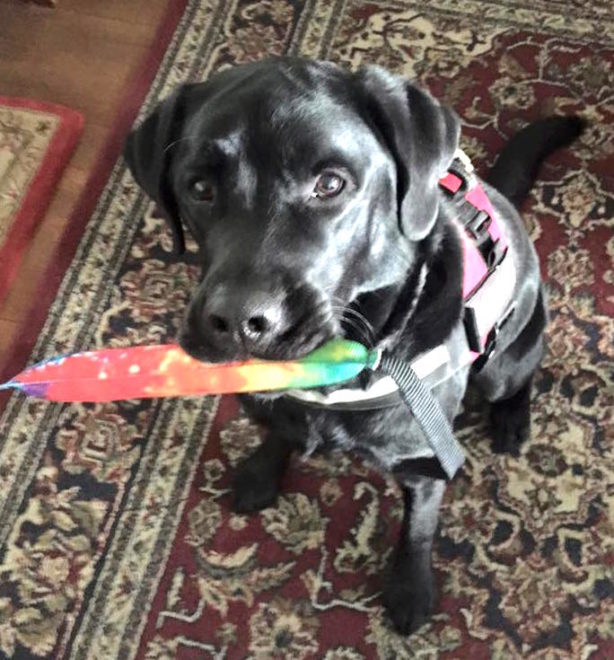How to Get the Diabetic Alert Dog You Want

Almost five years ago, my son Luke was diagnosed with type 1 diabetes when he was 2 years old. We immediately researched everything we could to help us care for him. He was on a pump and Dexcom Continuous Glucose Monitor (CGM )within a few months and then we started looking into a diabetic alert dog (DAD). DADs are fairly new to the service dog world, so we had trouble finding resources to help us navigate through the process; we couldn’t even find a video of an alert!
We unfortunately started our journey with a company that we chose to leave because they were being sued by many unhappy families. We left and lost our money and faith, until we found Canine Hope for Diabetics, and Jedi. We self-trained him with the invaluable help of their professional trainers.
Fast forward four years later and Luke and Jedi are a wonderful working team. We have been sharing our story on in an effort to raise awareness for type 1 diabetes (T1D) and these dogs. A DAD isn’t right for everyone and that’s okay, if you are interested in a dog, please educate yourself, so you can make an informed decision that is right for YOUR family. These dogs add to the care you provide they do not replace anything you already do; they are also a lot of work.
Things I wish I knew to research and ask about…
Don’t rush!
Waiting lists exist because it takes time to raise and properly train these dogs, very short waiting lists may mean the dogs are receiving less training, or too many dogs are being put out too quickly ,which history has shown, can be a recipe for disaster. Speak to several organizations, interview them, as they will most likely will also be interviewing you to see if you will be a good candidate. Some companies accept everyone who pays the deposit while some have an interview process and select candidates based on criteria they believe will make the team successful.
Don’t pick an organization solely on someone’s recommendation
What works for one family may not work for you. Recommendations are a good place to start but not the only way to decide.
Think about how much training do you want your dog to have
- A puppy should be the least expensive option, but comes with the most risk and most amount of work required on your part. A puppy is not a diabetic alert dog, they are a service dog in training. NO ONE can guarantee that a puppy will make it. You can self train, but it is highly suggested you enlist the help of a professional dog trainer (preferably one that understands service dogs) to help you evaluate the puppy’s temperament and drive to help decide if they are a good candidate and then to assist with ongoing training.
- A started dog (roughly nine months- 1year) should have basic obedience in place and may be beginning to alert but you will need to continue the training for both.
- Fully trained dogs are the most expensive option because most of the upfront work has been done for you. These dogs are often over 1.5 years old, they have proven alert ability, and hundreds of hours of public access work.
- Training is forever for ALL dogs, regardless of how much training your dog had, if you stop working with them, they will stop alerting.
How will YOU be trained?
The handler needs training just as much as the dog does if not more. A few hours or even a few days many not be enough to ensure success.
Consider ongoing support
What does it look like? Do they provide it? Training is forever and a dog transitioning into a home takes time. What happens if in six months or a year you are experiencing difficulty, will they support you, help you, guide you?
Know what kind of alert you want
What will you benefit the most from? Jedi alerts every time Luke drifts up over 155 and below 80; he re-alerts to highs every hour and every 5-10 minutes for lows. Some dogs are trained to alert to fluctuations of any kind (not necessarily highs and lows) and some dogs only alert to lows.
- Night Alerts. NOT EVERY DOG ALERTS AT NIGHT and even those that do alert CAN and DO miss things; they are living creatures not robots. So if you think a dog will help you “sleep more” you may be in for a surprise. Having a DAD often means less sleep since you have to respond to each alert and it most likely will take a lot of training on your part to get night alerts happening.
- What do alerts look like? Will the dog lick you, paw you, or fetch a device like a bringsel to tell you there is an issue. Barking can be disruptive and should not be a primary alert and used only if their handler is not responding or the dog can’t get to a person to alert.
- Read Here’s the Thing About Night Alerts and Nighttime Alerting, the Holy Grail From Black Dogs Rule.
Know the dog’s medical history
Ask about the dog’s medical history. Hips, eyes, joints, heart issues, can’t be foreseen, however things can be done to increase the probability that the dog will be able to work for a very long time.
Know where it was raised
Ask about how the dog was raised. Service dogs should be raised with in homes. It has proven unsuccessful when dogs are raised solely in kennels; they often have difficulty adjusting to living with families at placement.
Make sure your dog likes children
Some dogs don’t like children, if the dog will be placed around children ask the organization how they will choose a dog that will be successful in that situation. Learn about calming and stress signals in dogs.
Ask what they do with dogs that don’t make the cut
NO ORGANIZATION for any type of service dog has a 100 percent success rate. Dogs are often “career changed.“ Too much drive—maybe they can do search and rescue work, too little drive—maybe they can be a guide dog, if they send every puppy out from every litter to be a serviced dog I would be very concerned.
Ask about their dogs in-service
How many years have they been training DADs and/or service dogs? How long has their longest team been working?
Make sure the organization is reputable
Check the BBB and attorney general reports for the organizations you are considering, google diabetic alert dog scams. Early research showed that only 50 percent of DAD’s were still alerting two years after placement which is very unfortunate considering how helpful these dogs can be when they are placed responsibly and given the right training and support. Be weary of organizations that claim to have a special certification, since there are not, as of yet, national standards for training established.
Read Luke and Jedi a Documentary about a Boy’s Best Friend. Learn more abut Diabetic Alert Dogs HERE.





